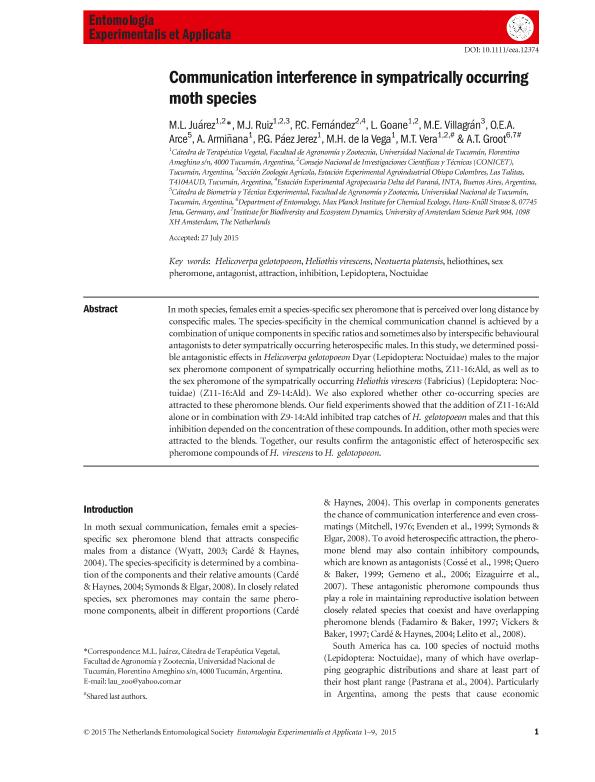Mostrar el registro sencillo del ítem
dc.contributor.author
Juárez, María Laura

dc.contributor.author
Ruiz, María Josefina

dc.contributor.author
Fernandez, Patricia Carina

dc.contributor.author
Goane, Lucía

dc.contributor.author
Villagrán, M. E.
dc.contributor.author
Arce, Osvaldo Ernesto Antonio

dc.contributor.author
Armiñana, A.
dc.contributor.author
Páez Jerez, Paula Gabriela

dc.contributor.author
de la Vega, Marcelo Horacio

dc.contributor.author
Vera, María Teresa

dc.contributor.author
Groot, A.T.
dc.date.available
2018-09-27T14:23:02Z
dc.date.issued
2016-01
dc.identifier.citation
Juárez, María Laura; Ruiz, María Josefina; Fernandez, Patricia Carina; Goane, Lucía; Villagrán, M. E.; et al.; Communication interference in sympatrically occurring moth species; Wiley Blackwell Publishing, Inc; Entomologia Experimentalis et Applicata; 158; 1; 1-2016; 25-33
dc.identifier.issn
0013-8703
dc.identifier.uri
http://hdl.handle.net/11336/61026
dc.description.abstract
In moth species, females emit a species-specific sex pheromone that is perceived over long distance by conspecific males. The species-specificity in the chemical communication channel is achieved by a combination of unique components in specific ratios and sometimes also by interspecific behavioural antagonists to deter sympatrically occurring heterospecific males. In this study, we determined possible antagonistic effects in Helicoverpa gelotopoeon Dyar (Lepidoptera: Noctuidae) males to the major sex pheromone component of sympatrically occurring heliothine moths, Z11-16:Ald, as well as to the sex pheromone of the sympatrically occurring Heliothis virescens (Fabricius) (Lepidoptera: Noctuidae) (Z11-16:Ald and Z9-14:Ald). We also explored whether other co-occurring species are attracted to these pheromone blends. Our field experiments showed that the addition of Z11-16:Ald alone or in combination with Z9-14:Ald inhibited trap catches of H. gelotopoeon males and that this inhibition depended on the concentration of these compounds. In addition, other moth species were attracted to the blends. Together, our results confirm the antagonistic effect of heterospecific sex pheromone compounds of H. virescens to H. gelotopoeon.
dc.format
application/pdf
dc.language.iso
eng
dc.publisher
Wiley Blackwell Publishing, Inc

dc.rights
info:eu-repo/semantics/openAccess
dc.rights.uri
https://creativecommons.org/licenses/by-nc-sa/2.5/ar/
dc.subject
Antagonist
dc.subject
Attraction
dc.subject
Helicoverpa Gelotopoeon
dc.subject
Heliothines
dc.subject
Heliothis Virescens
dc.subject
Inhibition
dc.subject
Lepidoptera
dc.subject
Neotuerta Platensis
dc.subject
Noctuidae
dc.subject
Sex Pheromone
dc.subject.classification
Otras Ciencias Biológicas

dc.subject.classification
Ciencias Biológicas

dc.subject.classification
CIENCIAS NATURALES Y EXACTAS

dc.title
Communication interference in sympatrically occurring moth species
dc.type
info:eu-repo/semantics/article
dc.type
info:ar-repo/semantics/artículo
dc.type
info:eu-repo/semantics/publishedVersion
dc.date.updated
2018-09-26T15:00:28Z
dc.journal.volume
158
dc.journal.number
1
dc.journal.pagination
25-33
dc.journal.pais
Reino Unido

dc.journal.ciudad
Londres
dc.description.fil
Fil: Juárez, María Laura. Consejo Nacional de Investigaciones Científicas y Técnicas; Argentina. Universidad Nacional de Tucumán. Facultad de Agronomía y Zootecnia; Argentina
dc.description.fil
Fil: Ruiz, María Josefina. Consejo Nacional de Investigaciones Científicas y Técnicas; Argentina. Universidad Nacional de Tucumán. Facultad de Agronomía y Zootecnia; Argentina
dc.description.fil
Fil: Fernandez, Patricia Carina. Consejo Nacional de Investigaciones Científicas y Técnicas; Argentina. Instituto Nacional de Tecnología Agropecuaria. Centro Regional Buenos Aires Norte. Estación Experimental Agropecuaria Delta del Paraná; Argentina
dc.description.fil
Fil: Goane, Lucía. Consejo Nacional de Investigaciones Científicas y Técnicas; Argentina. Universidad Nacional de Tucumán. Facultad de Agronomía y Zootecnia; Argentina
dc.description.fil
Fil: Villagrán, M. E.. Gobierno de Tucumán. Ministerio de Desarrollo Productivo. Estación Experimental Agroindustrial Obispo Colombres; Argentina
dc.description.fil
Fil: Arce, Osvaldo Ernesto Antonio. Universidad Nacional de Tucumán. Facultad de Agronomía y Zootecnia; Argentina
dc.description.fil
Fil: Armiñana, A.. Universidad Nacional de Tucumán. Facultad de Agronomía y Zootecnia; Argentina
dc.description.fil
Fil: Páez Jerez, Paula Gabriela. Consejo Nacional de Investigaciones Científicas y Técnicas; Argentina. Universidad Nacional de Tucumán. Facultad de Agronomía y Zootecnia; Argentina
dc.description.fil
Fil: de la Vega, Marcelo Horacio. Universidad Nacional de Tucumán. Facultad de Agronomía y Zootecnia; Argentina
dc.description.fil
Fil: Vera, María Teresa. Consejo Nacional de Investigaciones Científicas y Técnicas; Argentina. Universidad Nacional de Tucumán. Facultad de Agronomía y Zootecnia; Argentina
dc.description.fil
Fil: Groot, A.T.. Max Planck Institute for Chemical Ecology; Alemania. University of Amsterdam; Países Bajos
dc.journal.title
Entomologia Experimentalis et Applicata

dc.relation.alternativeid
info:eu-repo/semantics/altIdentifier/doi/https://dx.doi.org/10.1111/eea.12374
dc.relation.alternativeid
info:eu-repo/semantics/altIdentifier/url/https://onlinelibrary.wiley.com/doi/abs/10.1111/eea.12374
Archivos asociados
